Realme has been aggressively broadening its reach, expanding both vertically and laterally. Less than two years ago, it was a brand vending entry-level phone to price-conscious Southeast Asians. But since then, it has matured into a poster-boy label for premium-grade value for money phones available in key global markets. More importantly, this stupefying surge has also threatened other brands, like Xiaomi, which rose on the proposition of affordability. Realme has dispensed some great quality phones in 2019 and put out noteworthy features like a pop-up selfie camera, Super AMOLED displays with in-display fingerprint scanners, 64MP rear camera setups, and most importantly, unparalleled charging speeds across different price segments. Until the Realme X2 Pro, Realme’s mid-range and their tending-to-premium lineup was limited to the Snapdragon 710/712 and this made it seem weaker when compared to the competition. To address this finally, Realme welcomed a Snapdragon 730G powered device into the family. The new phone is titled Realme X2 and while it may seem like a closer sibling to the X2 Pro, it shares many more traits with the Realme XT.

Realme first teased the X2 at the Realme XT launch in India and a week later, it was launched in China. In the following month of October, Realme launched the Realme X2 along with the X2 Pro in both China and Europe. The Realme X2 arrived in India around the end of December, as promised by the company, even though the Realme X2 Pro had already launched a month prior. Although the Realme X2 may be one of the last phones to launch in India in 2019, it was definitely one of the more noteworthy ones.
Like I said, the Realme X2 feels much more closely related to the Realme XT than the Realme X2 Pro. In fact, the Realme X2 uses the selfsame design, unmodified 64MP quad-camera setup, and identical RAM-storage configurations. The only differentiators are the new chipset, 50% faster charging, and an improved selfie camera. But interestingly, the prices of both the phones vary by only ₹1,000 (~$15) in India. The most compelling aspect among all of the changes in the Realme X2 is the new chipset and it brings improvements in terms of general everyday usage as well as gaming. Owing to the latest chipset and the 64MP cameras, Realme is marketing the smartphone as a “64MP Performance Xpert.”
I had a chance to test out the 8GB RAM variant of the Realme X2, which was loaned to us by Realme India. In this review, I mainly focus on the impact of the new Snapdragon 730G chipset on the phone’s performance, which has been analyzed over a period of two weeks. Additionally, the piece also weighs the Realme’s X2’s faster 30W charging.
TL;DR –
| Pros | Cons |
|---|---|
|
|
Buy in India: 4GB/64GB (₹16,999) || 6GB/128GB (₹18,999) || 8GB/128GB (₹19,999)
Buy in Europe (only 8GB/128GB): Italy (299 €) || Spain (279 €) || France (299 €) || Germany (299 €)
Realme X2 Specifications
| Specifications | Realme X2 |
|---|---|
| Dimensions & Weight |
|
| Display |
|
| SoC |
|
| RAM | 4GB/6GB/8GB |
| Storage | 64GB/128GB UFS 2.1 Dedicated microSD slot |
| Battery | 4000mAh, 20W VOOC 3.0 fast charging |
| Fingerprint Sensor | In-display fingerprint |
| Rear Camera |
|
| Front Camera |
|
| Android Version | ColorOS 6.1 based on Android 9 Pie |
| Colors | Pearl White, Pearl Blue, Pearl Green |
Why Snapdragon 730G?
Powered with a Snapdragon 730G, the Realme X2 takes on the Redmi K20 (Mi 9T), which was launched alongside its Pro sibling exactly five months ahead of the Realme X2. There are some visible differences between the Realme X2 and the Redmi K20 (Mi 9T) and trade-offs with each of the devices. Besides being a newer device, the Realme X2 Pro exceeds Redmi K20 (Mi 9T) by means of a more powerful GPU, higher camera resolution, better display quality, faster charging, a sleeker design, and an additional 8GB RAM option, which is unavailable for the Redmi. The Redmi, on the other hand, comes with an unhindered notchless display and already has Android 10 along with a more mature UX in the form of MIUI 11.
Since there aren’t many performance-oriented phones – or, deputy flagships – in the sub-₹25,000 (~$350) segment, Realme has a fairly good chance of one-upping against Xiaomi’s Redmi, especially since the Realme X2 is cheaper. So far, Qualcomm’s Snapdragon 730G is among the best-performing chipsets in the top tier of the mid-range segment. The tech community is only starting to warm up to the idea of Snapdragon 765G, which is the first mid-range 5G chipset and the successor to the Snapdragon 730G. So far, we’ve only seen two devices – the Redmi K30 5G and the OPPO Reno3 Pro – powered by the Snapdragon 765G but these are currently limited to China.
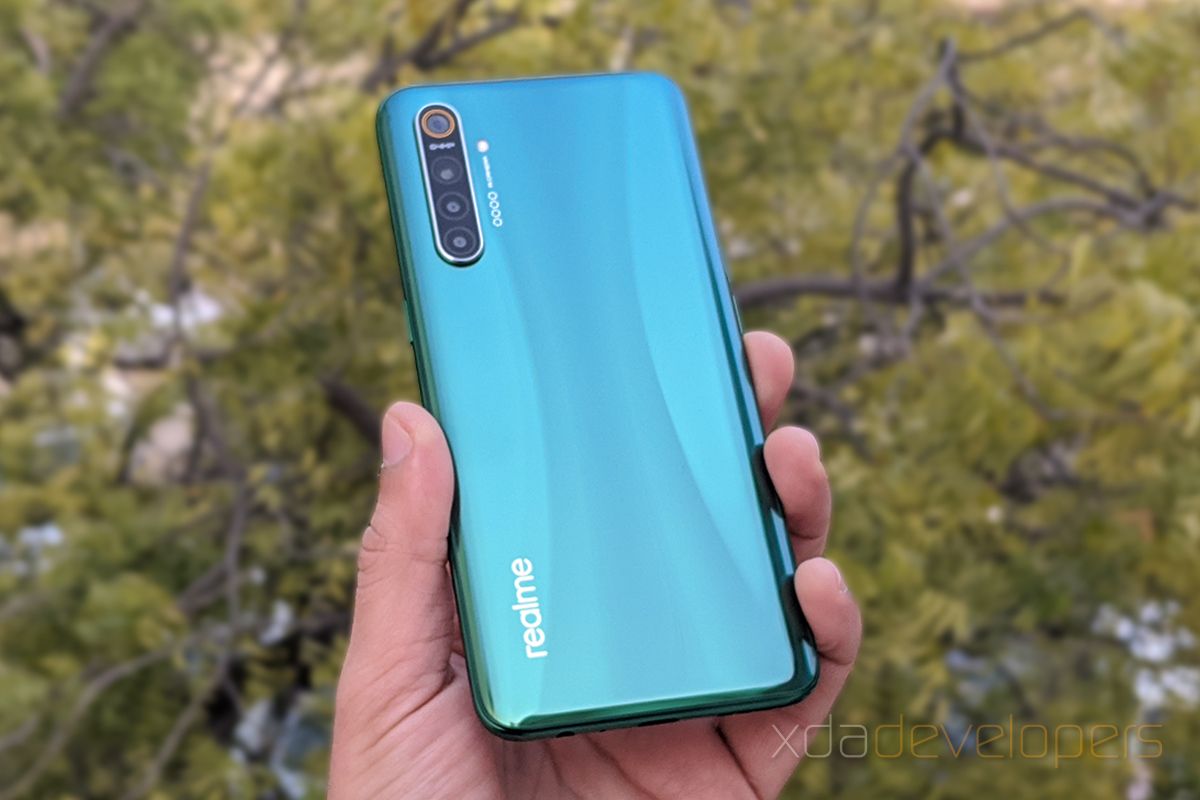

The Snapdragon 730G and the Snapdragon 730, which powers the Redmi K20 (Mi 9T), are predominantly the same and the only difference is the overclocked Adreno 618 GPU on the former. Due to its higher GPU frequency, the Snapdragon 730G should have up to 15% better graphic performance compared to the regular, sans-G variant. In terms of CPU, both of these use an octa-core design with Arm’s big.LITTLE architecture, making use of two performance and six power-efficient cores.
The Snapdragon 730G mobile platform is obviously good news for those who have a hunger for gaming besides a craving to capture more with the 64MP camera. This setup is expected to outperform the Snapdragon 710/712 on previous Realme devices – including the Realme 3 Pro and the Realme X – as well as the Snapdragon 675, which seemed to dispense better benchmarks scores during our review of the Redmi Note 7 Pro.
Realme was cornered in India for using an older Snapdragon 710 on the Realme 3 Pro; so, the Snapdragon 730G should pacify these expectations and also delight Realme fans awaiting a real performer.
The routine churn of benchmark results helps us gain some perspective on the performance as well as the improvements on this phone compared to all of the mid-rangers launched by Realme this year.
Performance: Realme X2 wrestles Redmi K20 and Note 8 Pro
The performance jump from the Snapdragon 712 on the Realme XT to the Snapdragon 730G on the Realme X2 is quite ubiquitous. The Snapdragon 712 features an octa-core design featuring two Kryo 360 Gold cores clocked at 2.3GHz and six Kryo 360 Silver cores clocked at 1.7GHz. The Snapdragon 730G is equipped with two high-performance Kryo 470 Gold cores clocked at 2.20GHz and six high-efficiency Kryo 470 Silver cores with a frequency of 1.8GHz.
To quantify this upgrade over the older chipset, I’m using standard synthetic benchmarking apps. For the comparison, I’m using the benchmark scores from our review of the Realme 5 Pro, which uses exactly the same internal hardware as the Realme XT.
The comparison also ropes in Xiaomi’s Redmi Note 8 Pro, which sports a MediaTek Helio G90T chipset and was hailed as the “mid-range performance champion” by Arol in his review of the phone. The Helio G90T and the Snapdragon 730G have a fairly similar microarchitecture. Both of the chipsets have an octa-core architecture with two high-performance cores based on Arm’s Cortex A76 design and six high-efficiency Cortex A55 cores but the CPU clusters have different clock speeds. In contrast to the aforementioned clock speeds of the performance and efficiency cores on the Snapdragon 730G, the Mediatek Helio G90T’s performance cores at clocked at 2.05GHz whereas the power-efficient cores have a clock speed of 2.0GHz. Another thing to note is that while Snapdragon 730G features an 8nm design, the Helio G90T is built on a 12nm process. This suggests that, in theory, the Snapdragon 730G should be more power-efficient. At the same time, the 800MHz Mali-G76 MP4 GPU on the Helio G90T is likely to exceed the Snapdragon 730G’s Adreno 618 – clocked at 575MHz – very easily.
| SoC | Qualcomm Snapdragon 710/712 | Qualcomm Snapdragon 730/730G | MediaTek Helio G90T |
|---|---|---|---|
| CPU |
|
|
|
| GPU |
|
|
Mali G76 MP4 @ 800MHz |
An obvious runner in this competition is the Redmi K20 (Mi 9T) and with it comes the more powerful sibling – the Redmi K20 Pro (Mi 9T Pro), which is currently the most affordable Snapdragon 855 smartphone available outside of China.
Benchmarks
I’m starting the comparison by taking Geekbench scores of the Realme X2 into account and comparing them to other devices. Against the Realme 5 Pro, the Realme X2 shows a mighty 70% leap in terms of the single-core CPU scores while showing a nearly 20% increase in the multi-core scores in Geekbench 4. The Redmi K20 Pro (Mi 9T Pro) fares much higher thanks to the higher frequency of the eight Kryo 470 cores in the Snapdragon 855. Since Geekbench 5 was launched after we reviewed the Realme 5 Pro, I only have older scores for the device.
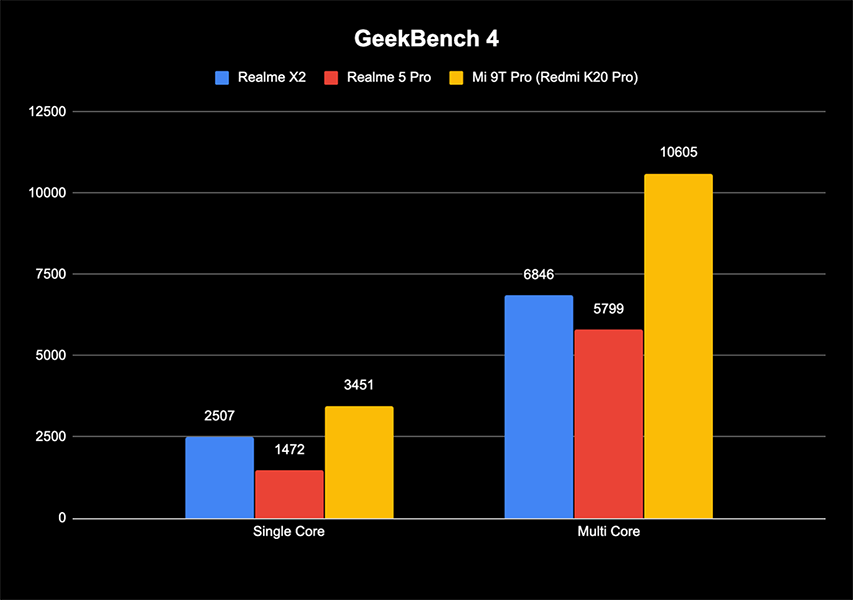
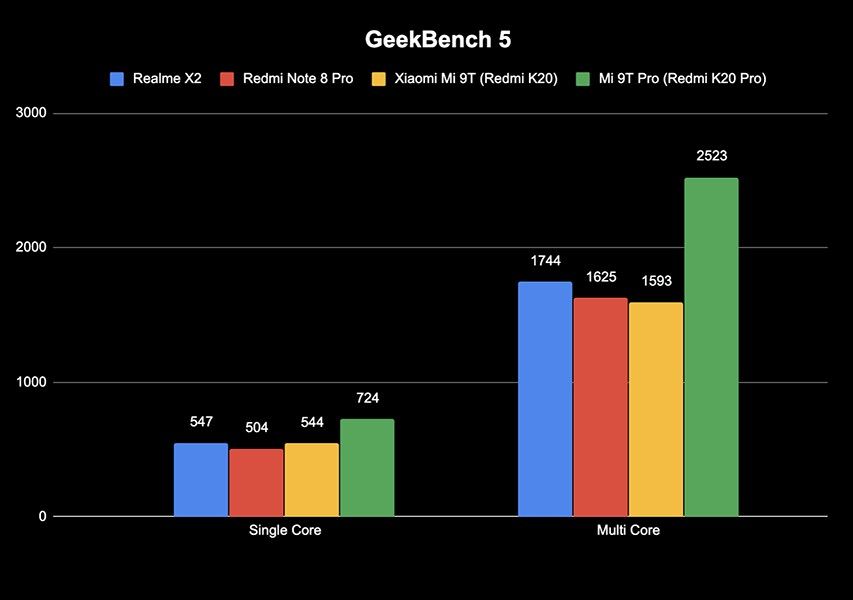
For another comparison of the Realme X2’s CPU performance with Redmi Note 8 Pro and the Redmi K20 (Mi 9T), I’m relying on Geekbench 5. The single-core score for the Realme X2 lies in the same ballpark as the Redmi K20 (Mi 9T) since both share the same CPU. In contrast, Redmi Note 8 Pro’s Helio G90T lags behind by a small margin of less than 10%. Meanwhile, in terms of the multi-core CPU performance scores for the aforementioned devices, the Realme X2 leads both the Redmi Note 8 Pro as well as the Redmi K20 (Mi 9T) by a margin of 7.5% and 9.5%, respectively.
Geekbench 5 (Free, Google Play) →
Moving on to AnTuTu, one of the most popular benchmarks which look at the performance of any device holistically. The tests rate a device’s performance individually – by rating the CPU, GPU, RAM, and the user experience separately, then adding the subscores for one final score. As we see from the comparison graphs, the Realme X2 leads the Redmi Note 8 Pro and the Redmi K20 (Mi 9T) in terms of CPU performance rated by AnTuTu. But when it comes to GPU score, the Redmi Note 8 Pro takes the lead due to the higher clock speed of the variant of Mali-G76 GPU on the Helio G90T SoC. The Redmi K20 (Mi 9T), on the other hand, remains behind the Realme X2 due to a lower clock speed of its GPU. Noticeably, the Realme X2 lags behind all of the other phones in the UX test, indicating that MIUI might be better optimized compared to ColorOS for actions like scrolling and flowing through the interface.

The Realme X2 still lags behind the Redmi Note 8 Pro in memory-related tests. Contrary to this trend, however, the Realme X2 does better than the Redmi K20 (Mi 9T) and Redmi K20 Pro (Mi 9T Pro) running MIUI 10. The score is unusually low and might be due to a technical error or lack of proper support for the specific benchmark test. Alternatively, it could also be because the Realme X2 and the Redmi Note 8 Pro were tested using AnTuTu v8 while the remaining devices were tested with an older version of the app. Validating this assumption, AnTuTu v8 on the Redmi K20 Pro (Mi 9T Pro) running MIUI 11 score definitely reflected significant improvement. Overall, however, the Realme X2 leads the Redmi K20 (Mi 9T) but lags behind the Redmi Note 8 Pro.
AnTuTu Benchmark (Free, Google Play) →

My next test is PCMark’s Work 2.0 which simulates real-life usage scenarios to test a smartphone’s abilities for productivity-centric tasks such as web browsing, text editing, photo and video editing, and interactions with data and graphs on spreadsheets. Here, the Realme X2 is clearly doing significantly better than the Realme 5 Pro and the Redmi K20 (Mi 9T) but is beaten by the unusually high score of the Redmi Note 8 Pro, which is even higher than the Redmi K20 Pro (Mi 9T Pro). In the Note 8 Pro’s review, Arol confirmed that the similar results came up in spite of multiple iterations. These results along with the UX score from AnTuTu depict that the Redmi Note 8 Pro is expected to offer a smoother experience even though the Realme X2 fares better in terms of its processing abilities.
PCMark for Android Benchmark (Free, Google Play) →

Moving on to the 3DMark, which tests the graphic rendering capabilities of smartphones, we see Realme X2 rising above Realme 5 Pro and the Redmi Note 8 Pro in tests employing both – OpenGL ES 3.1 and Vulkan – APIs. Interestingly, this contradicts the trends we see in AnTuTu’s GPU tests. Furthermore, while the Redmi K20 (Mi 9T) fares below Realme X2 Pro in the OpenGL test, the contest reverses with the Vulkan API scores. The Redmi K20 (Mi 9T) actually scores higher on the 3DMark Vulkan test even with a weaker GPU, although the difference is only about 2%.
3DMark - The Gamer's Benchmark (Free, Google Play) →

Bringing the battle to the transfer speeds of the storage for these devices, the performance is more or less similar when assessed through AndroBench. A UFS 2.1 NAND storage, is considerably faster than eMMC storages, is common to all of these devices as expected, we see comparable results. Even though the Redmi K20 Pro (Mi 9T Pro) features the same storage technology, it has higher transfer speeds, especially in the case of sequential IO. This is because the dual-lane transfer on UFS 2.1 storage systems is not supported by the chipsets on the other devices. Furthermore, there is a visible dip in the random write speeds of both the Realme devices but not the Redmi phones in the comparison. The reason behind this is unclear, but it could be because of better implementation of data indices in MIUI as compared to ColorOS.
Androbench (Storage Benchmark) (Free, Google Play) →
Thermal throttling
Smartphones these days come with heating protection, often in the form of throttling algorithms for the CPU and the GPU. Therefore, the performance is restricted to avoid any form of overheating because of and during a long gaming session or performance-intensive usage or while charging. To test if there’s any thermal throttling on the Realme X2, I used an app called CPU Throttling Test and the graphs below show results.
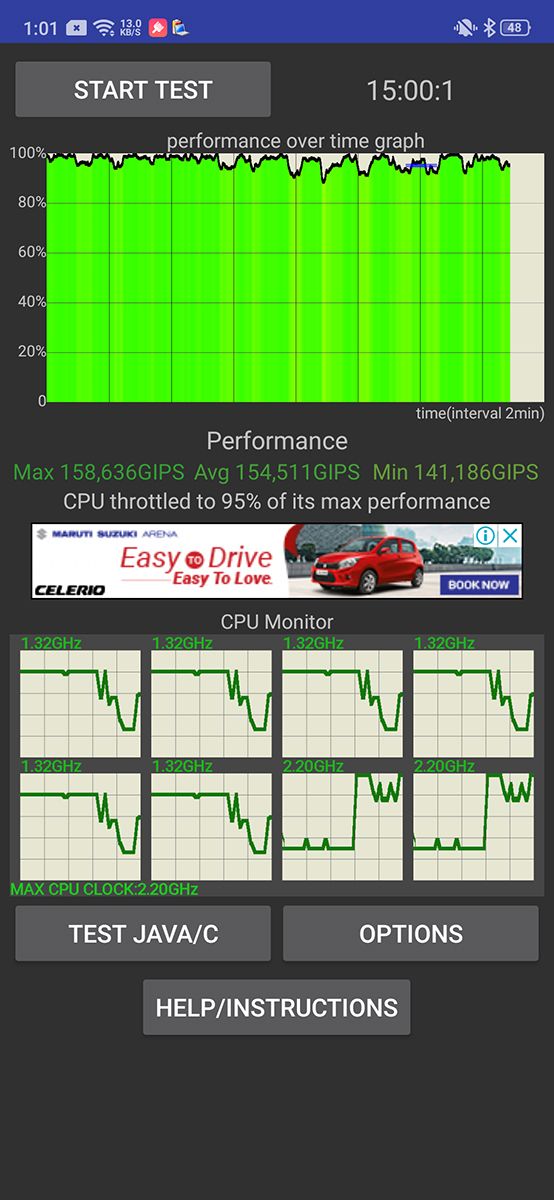
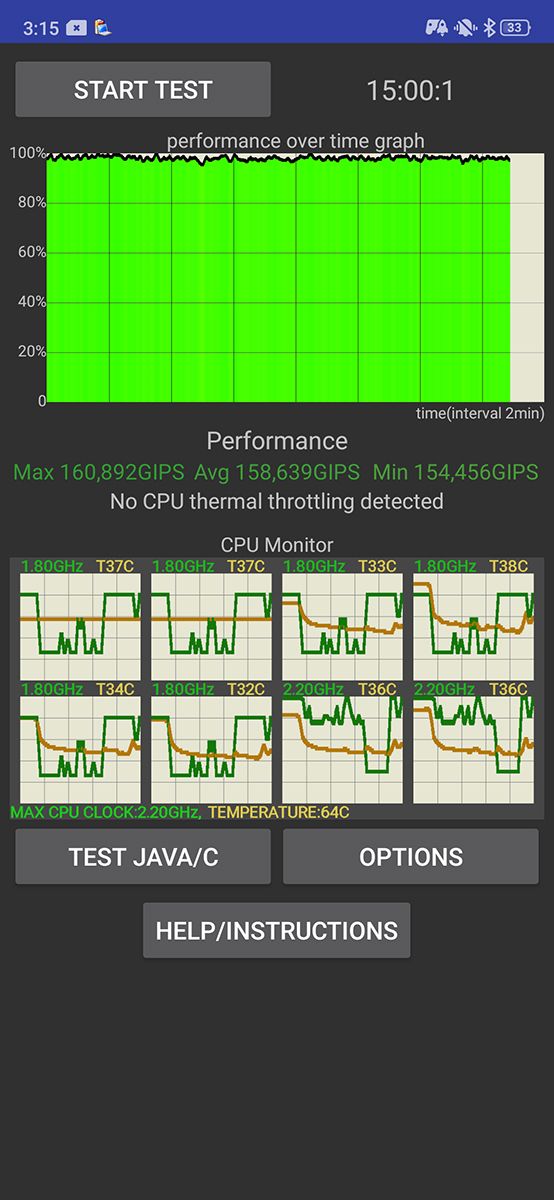
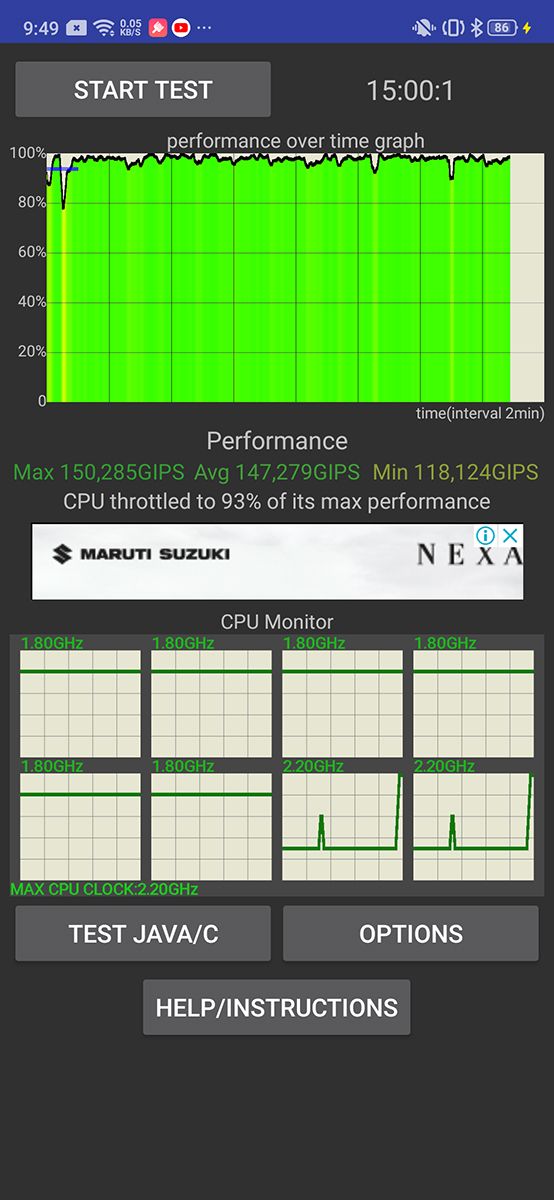
The one on the leftmost corresponds to results without Realme’s dedicated gaming mode called Game Space, the one in the middle shows the results produced when the app is accelerated using Game Space, while the one on the right shows results when the phone was put on charging. In the test run without Game Space, the CPU usage is throttled at around 95% of the peak performance. When using Game Space, however, there is no throttling observed. Other than that, there’s a minor (~1%) increase in the peak and average frames per test cycle. Lastly, while charging, the heat results in the performance being throttled to 93%, which is still acceptable. In real life, the phone does not heat up a lot while gaming and this is a good sign for users who enjoy long gaming sessions. The insignificant throttling during charging also indicates that you can continue to game while keeping the phone plugged in for charging.
CPU Throttling Test (Free, Google Play) →
Gaming
The synthetic benchmarks give us a fair idea about the general performance trends we can expect from the Realme X2 along with a decent comparison with other rivals. To measure the Realme X2’s real-life performance, I played some of the most popular and demanding games.
Here’s a rundown of the performance of these games measured with GameBench with sessions of nearly 30 minutes each. It must be noted that these games have been boosted by the inbuilt gaming mode called Game Space.
Asphalt 9

Starting with Asphalt 9, the Realme X2 renders lag-free gameplay. The frame rate, although consistent, is capped at 30fps for the phone and the resulting performance remains the same, irrespective of whether you choose High Performance or High Graphics in the game’s Visual Settings. As expected, the frame rate drops slightly when there’s a sudden change of the landscape or when the vehicle crashes but the major frame rate drops occur on loading screens. Overall, the Realme X2 fares as a good phone with a smooth Asphalt 9 gaming performance.
Asphalt 9: Legends - 2019's Action Car Racing Game (Free+, Google Play) →
PUBG Mobile
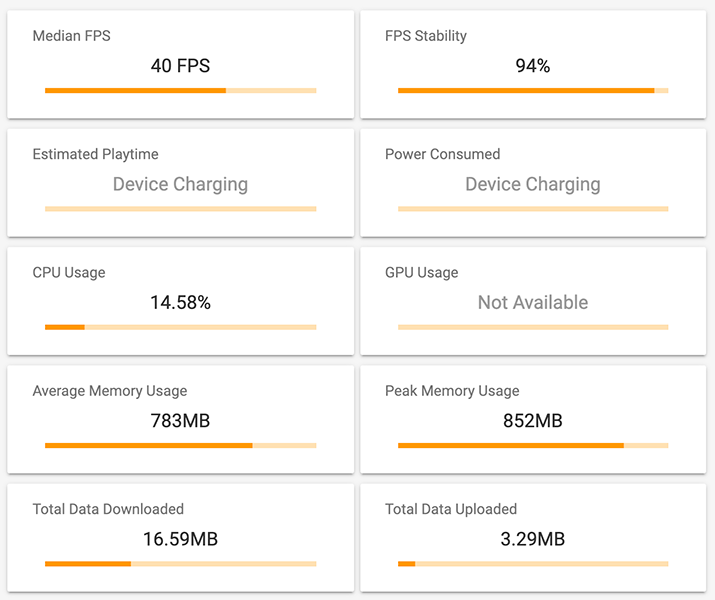

With PUBG Mobile, the Realme X2 supports the “Ultra” frame rate option as the highest setting. This means that it only facilitates a maximum of 40fps in theory. In PUBG Mobile, the gameplay is fairly smooth and there’s barely any frame rate drop. The changes in textures of the landscape do result in minor frame rate drops but otherwise, the gameplay remains sweet and enjoyable.
The Extreme graphics i.e. 60fps gameplay option can be unlocked with GFX tools like the PUB Gfx Tool app but do note some users suggest that doing so might result in a temporary ban. Just to clarify, I haven’t received any warning from Tencent yet so I would continue over-revving the frame rate until I get caught – but that does not mean you should too, especially if you’re a high-ranker in the game. Running PUBG Mobile on a higher frame rate doesn’t result in any cutbacks in performance, even though the CPU usage increases slightly. Even on Extreme graphics, the frame rate consistently floats around the 60fps mark, indicating that the Reame X2 can very well play PUBG Mobile at a higher setting whenever official support arrives on the phone.
PUBG MOBILE (Free+, Google Play) →
Call of Duty Mobile

Call Of Duty Mobile natively supports Max frame rate setting which allows playing at 60fps. However, the animations and loading screens are maxed out at 30fps, leading to a lower FPS stability as compared to PUBG Mobile. While playing, the frame rate remains constant and hovers around the 60fps mark and the only frame rate drops are seen when you’re being shot at or are respawning.
Call of Duty®: Mobile (Free+, Google Play) →
Shadowgun Legends

Shadowgun Legends is one game that appears to stress the Realme X2. While the frame rate usually remains close to 60fps on High graphics settings, it drops occasionally to as low as around 40fps while inside the game with changes in the backdrop as well as when alien assailants are shooting at you. The frame rate also drops as you move around in the central lobby when not playing any quest. However, when the graphics quality is set to Ultra High, the jitter and frame drops hindering gameplay are more visible and drastic. Besides the jank, the frame drops and rare instances of freezing make the gameplay disengaging at Ultra High settings.
SHADOWGUN LEGENDS - FPS PvP and Coop Shooting Game (Free+, Google Play) →
The Realme X2 proves to be a fairly powerful and feature-rich device for gaming and intensive tasks. Not only does it have sufficient caliber for most modern games but it can also take on demanding chores like editing presentation slides and viewing graphs on the go. On top of that, Google ARCore support makes allows users to engage the world around them in play with apps like Just A Line.
Battery & 30W VOOC 4.0 charging
The Realme X2 rocks a 4000mAh battery, same as the Realme X2 Pro and a host of other Realme devices including the Realme 5 Pro and the Realme XT. The reasonably sized battery along with the battery optimizations in ColorOS 6.1 easily allows a battery life that lasts more than 24 hours and it effortlessly furnishes a screen-on-time of 6 hours per charge. In stand-by, the battery percentage on the phone – like other Realme devices – barely moves even if the phone remains untouched for hours on end. This means that even if the battery is below 5% at night, you can sleep through the night without fearing about the phone running out of battery overnight.

If, however, you would rather be able to sleep more peacefully by ensuring that the phone has enough battery, the VOOC 4.0 charging technology, which Realme borrows from its parent OPPO, allows the 4,000mAh battery on the Realme X2 to tank up in less than 70 minutes. While this may not be as astounding as the 50W SuperVOOC on the Realme X2 Pro, which charges the phone fully in about 30 minutes, OPPO’s Warp Charge equivalent is certainly exciting, especially since such as feature is not even seen on flagships from most other brands, let alone mid-rangers like the Realme X2.
The phone also supports charging with USB-PD supported charging bricks as well as OPPO’s or Realme’s VOOC 3.0 20W charger, which takes about 85 minutes to refill the battery. You can also use OnePlus’ Dash and Warp chargers to achieve similarly fast charging speeds.
Design
The Realme X2 has a design identical to the Realme XT and the only refreshing bit is the new Pearl Green color. Once again, the back panel is made of glass while the surrounding frame is made of plastic, which prevents it from getting unbearably hot after extensive gaming sessions. The ivy green back panel looks very charismatic and should please potential users or buyers from all age groups. This shade of green can also be seen in ColorOS’ gaming mode application, so the intended association with gaming is glaring.
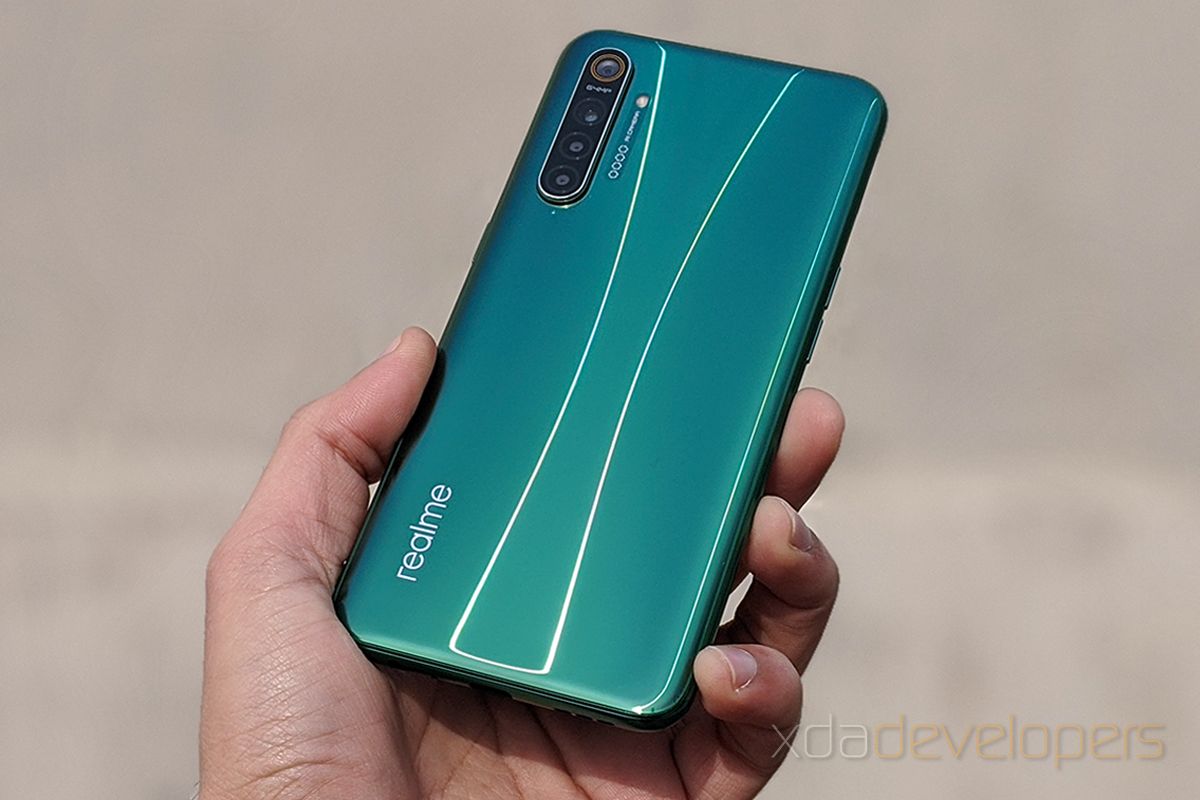
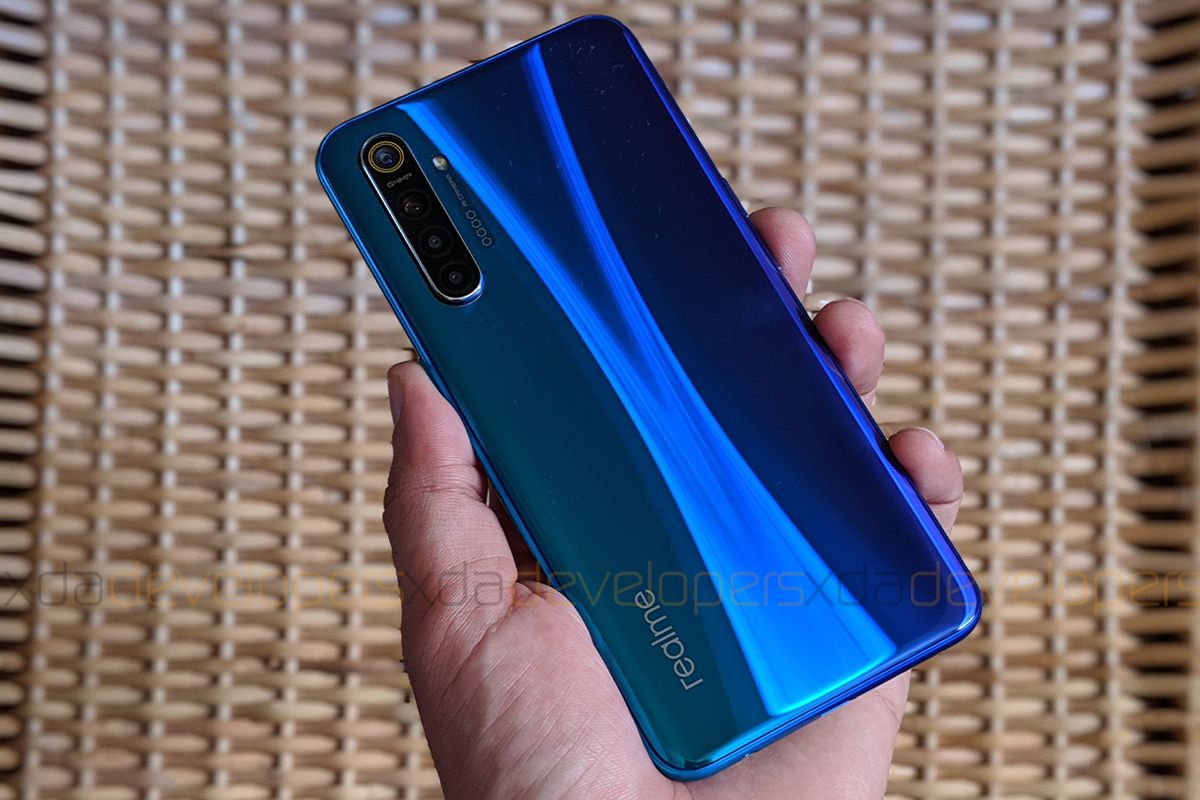
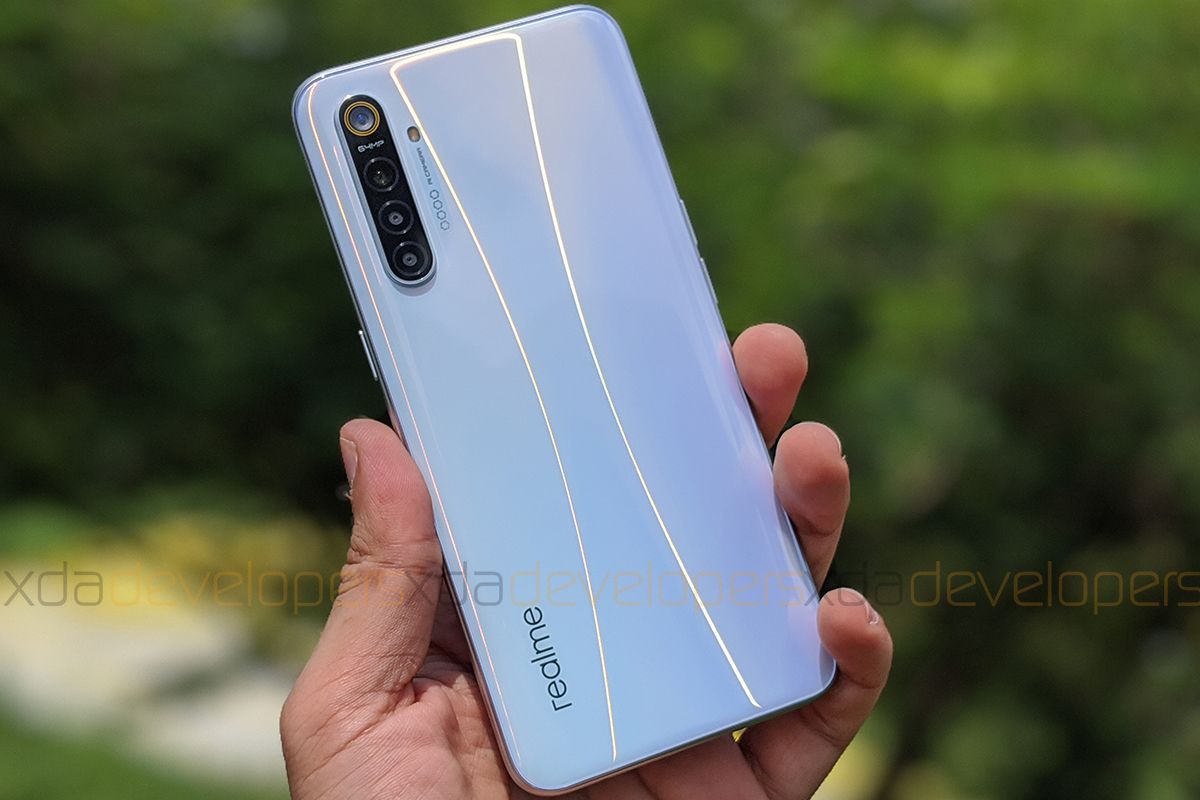
The Realme X2’s new green color along with older blue and white colors common to the X2 and XT
Unlike most other devices, the Realme X2’s frame gets much attention from the company’s design team. The surrounding frame is rather blandly curved, instead of finely pruned and chamfered frame on other Realme devices. Having used and reviewed numerous Realme mid-rangers through 2019, the lack of detail really irks me. The said chamfers not only add character to the design but also make holding the smartphone in landscape mode, while gaming or otherwise, fairly comfortable.
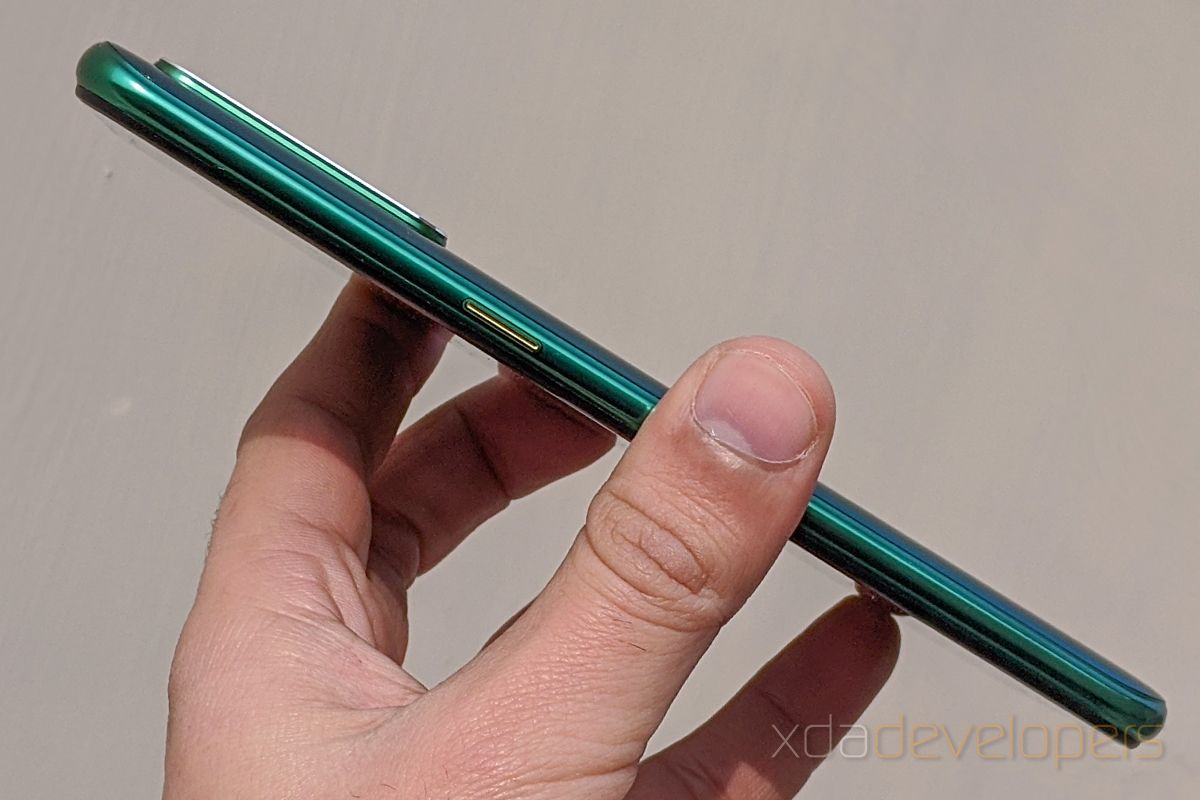

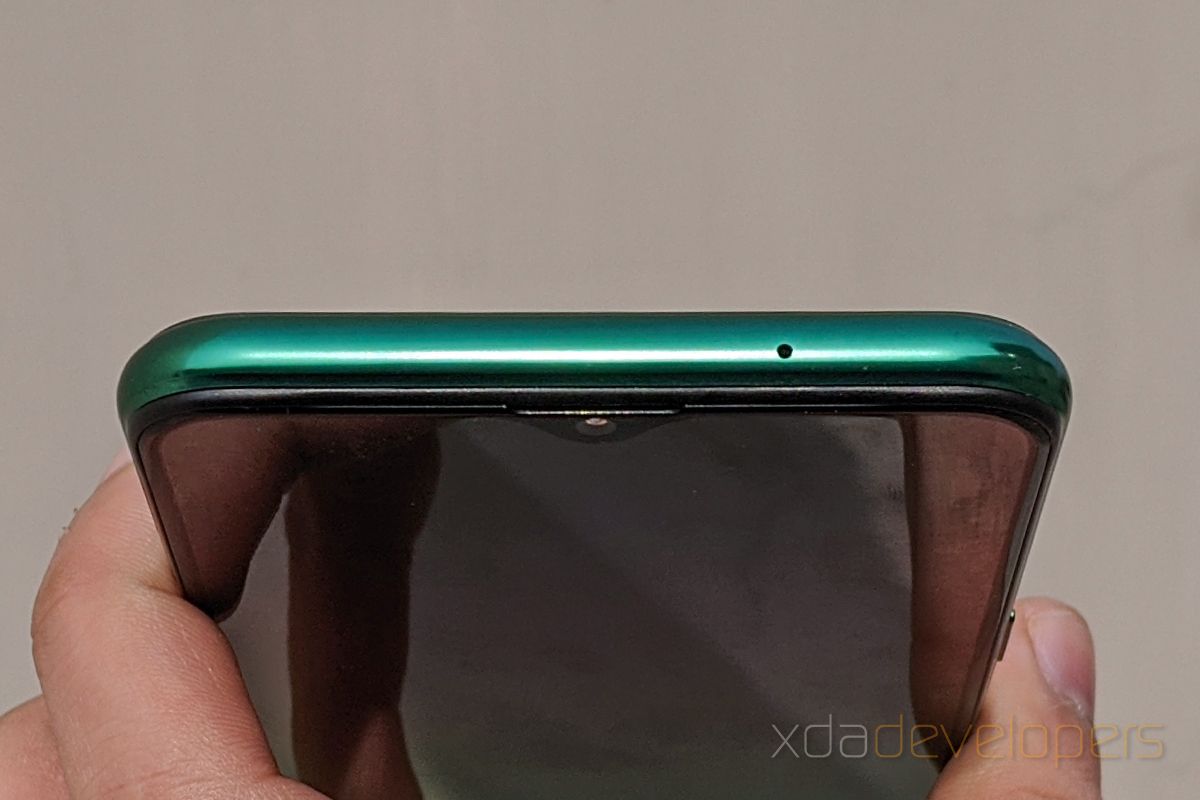

Besides the lacking ergonomics, the placement of the mono speaker is also not very satisfying since there is a good chance it will be jammed by your palm while gaming. This trade-off may be in favor of allowing easier access to the headphone jack, especially if what you’re using has a straight plug instead of a right-angled one. Obviously there isn’t much to worry about if you’re using a headset that uses Bluetooth or USB-C.
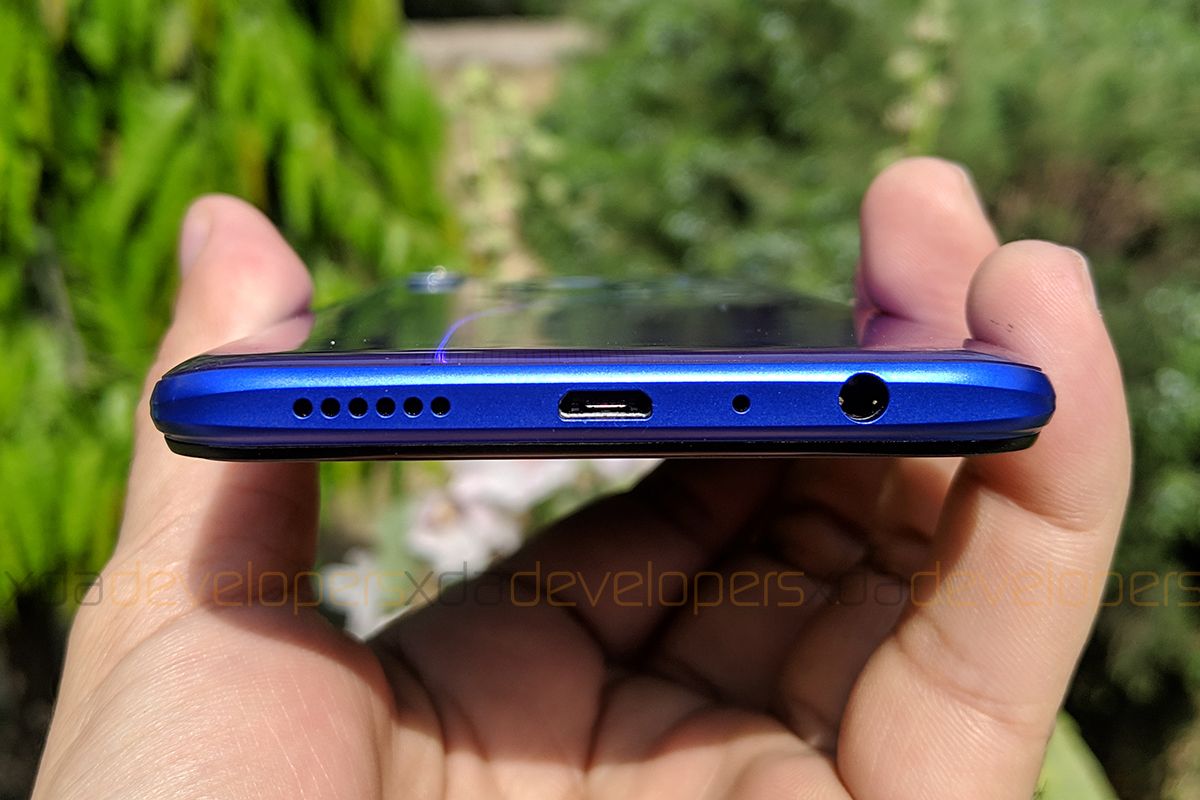
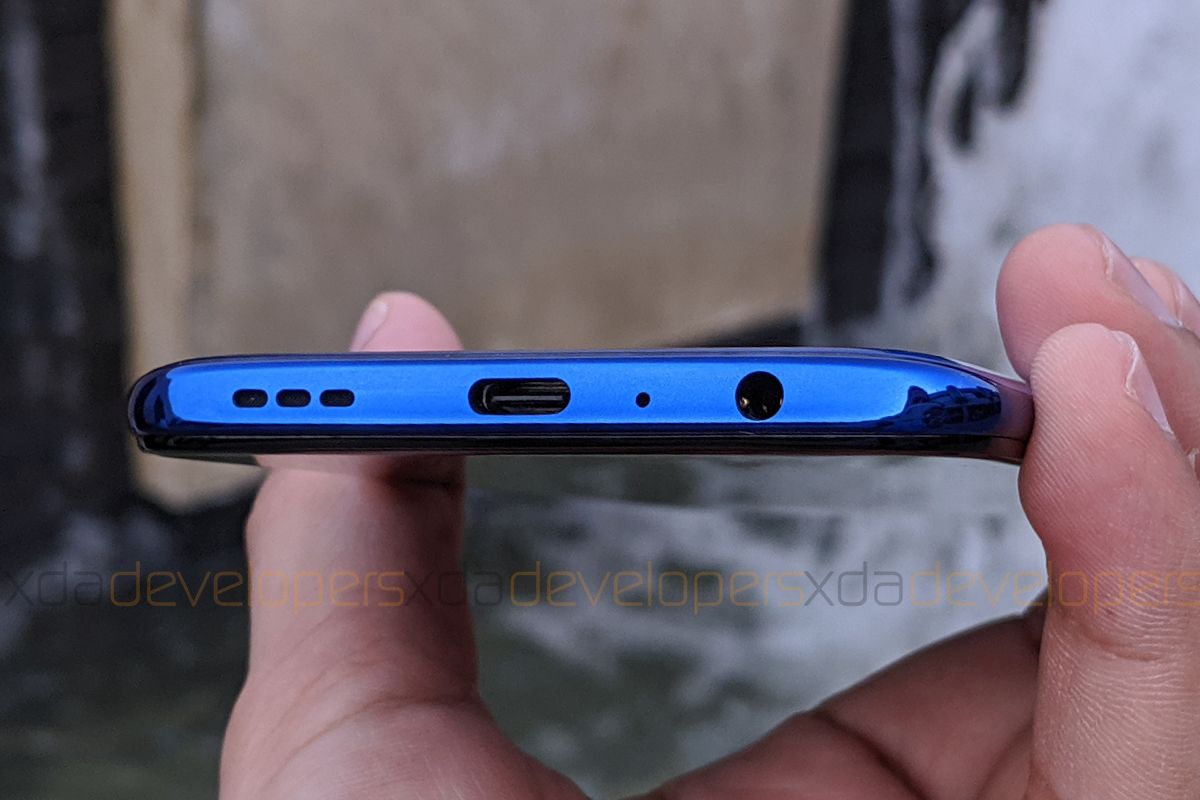
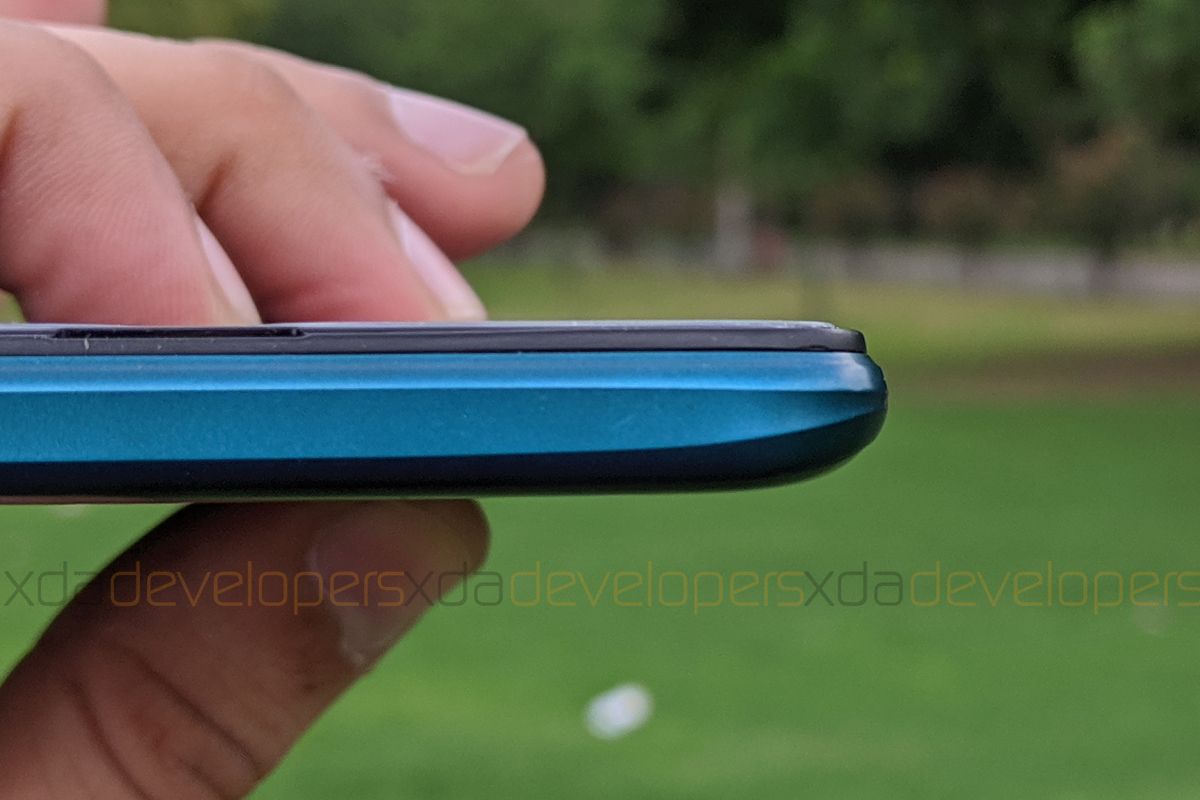
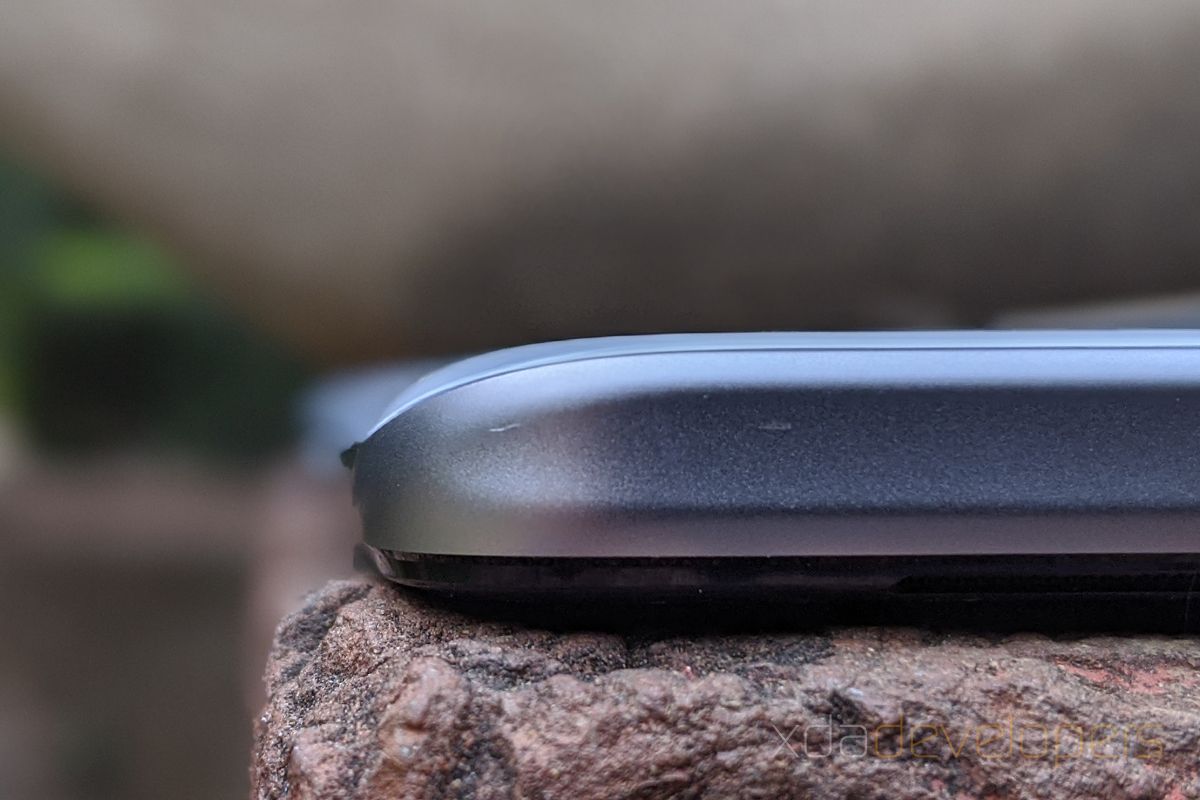
Chamfered frames offer better grip on Realme 3 Pro, Realme X, Realme 5 Pro, and Realme X2 Pro
Overall, the choice of plastic could be wise since metal rails transfer heat perceptibly – I observed Realme X2 Pro’s metal frame getting hot, for instance — but the rounded design lacks the traditional Realme flavor. If I’ve not already stressed enough, the phone is primarily targeted at users expecting relentless performance (not just gaming) and the Snapdragon 730G chipset should quench that thirst.
Supported LTE bands
| Region | LTE TDD | LTE FDD |
|---|---|---|
| China/India/Europe |
|
|
Development prospects
Realme projects itself as a pro-choice brand and wishes to support the interests of developers working independently or as part of the XDA community. As of now, the company has released the kernel sources for the Realme X2 but is yet to release a bootloader unlock tool for markets outside of China. The Chinese variant of Realme’s “In-Depth Test” app, which is used to register a request for bootloader unlocking, doesn’t work on the Indian unit I have.
The future of the development of Realme X2 depends upon the bootloader unlock tool and while the phone, in itself, is excellent for anyone looking to gaming more than just casually, click some great pictures, or utilize its vibrant and bright display for their entertainment, the device will fail to entice anyone willing install a custom firmware on it.
Realme X2: A new optimum for the mid-range performance
The Realme X2 does not need to beg for your attention since its excellent value for money already steals it anyway. The Realme X2 is the most affordable Snapdragon 730G smartphone available internationally, and that’s not the sole merit it possesses. Its Super AMOLED display along with a beguiling glass back design makes it a terrific smartphone in the mid-range. With all features aggregated together, the Realme X2 shines as one of the best mid-rangers that you should invest in, keeping in mind the condition that the third-party firmware and custom development support is currently limited. If you’re in the US, however, you might feel limited due to lack of proper support for LTE bands, so make sure you check for those before buying the smartphone.

The only problem with the Realme X2 is that it makes the Realme X and the Realme XT feel like smartphones in an older generation of X series smartphones by replacing them in less than 6 months. In a way, Realme did warn users who wanted better performance and not just a 64MP camera to wait for the Realme X2. But ₹1,000 price jump will make the early adopters feel like they paid a heavy price for the phone. With several launches in quick succession, the company has also reduced the shelf life of the so-called flagship smartphones that they launched earlier in 2019 and this might slash their value in the pre-owned smartphone market.
If, however, you did not give in to the temptation of being among the first users to enjoy a 64MP camera – or stayed away from the Redmi Note 8 Pro for its lack of a Snapdragon chipset, the Realme X2 looks like the finest phone you can get in exchange of your hard-earned money.
Buy in India: 4GB/64GB (₹16,999) || 6GB/128GB (₹18,999) || 8GB/128GB (₹19,999)
Buy in Europe (only 8GB/128GB): Italy (299 €) || Spain (279 €) || France (299 €) || Germany (299 €)
The post Realme X2 Performance & Gaming Review: The Finest Mid-Ranger of 2019 appeared first on xda-developers.
from xda-developers https://ift.tt/2SQet4v
via IFTTT


















